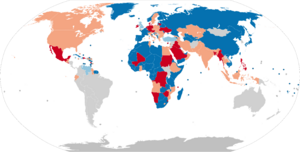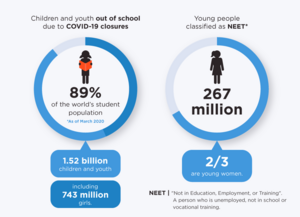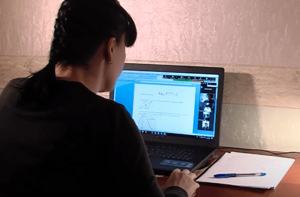Impact of the COVID-19 pandemic on education facts for kids
The COVID-19 pandemic greatly changed how education worked all over the world. When COVID-19 cases started to increase in March 2020, many schools and universities had to close. Most countries decided to temporarily shut down schools to help stop the spread of the virus.
UNESCO, a part of the United Nations, estimated that at the peak of these closures in April 2020, about 1.6 billion students in 200 countries were affected. This was 94% of all students globally. Schools were closed for about 41 weeks, which is more than 10 months. These closures had big negative effects on how much students learned. Experts believe this will have long-term impacts on both education and future earnings. Also, during the pandemic, money for education programs decreased.
The lockdowns especially affected students who were already struggling, and those in poorer countries. Students with less money found it harder to get an education, while those with more resources could continue learning. New online programs meant that families and individuals had to take on more of the teaching role, instead of schools. This made things much harder for people who relied on schools rather than computers or homeschooling. School closures also highlighted many social and economic problems, like student debt, digital learning, food security, and homelessness. It also affected access to childcare, health care, housing, internet, and services for people with disabilities. The impact was worse for disadvantaged children and their families. It led to interrupted learning, poor nutrition, childcare problems, and financial stress for families who couldn't work.
To help with school closures, UNESCO suggested using distance learning programs and free online learning tools. These tools could help schools and teachers reach students from far away and keep education going. In 2020, UNESCO predicted that nearly 24 million students would drop out of school, with South Asia and Western Asia being the most affected regions.
Contents
How Past School Closures Affected Health

To slow down the spread of COVID-19, actions like social distancing and self-isolation led to many schools closing. This included elementary, middle and high, and colleges in over 100 countries.
In the past, outbreaks of infectious diseases also caused widespread school closures. These closures had different levels of success. Studies have shown that closing schools can delay how fast a disease spreads. However, how well it works depends on what children do outside of school. School closures seem to reduce cases and deaths, especially if they happen early in an outbreak. If schools close too late, they are less effective. Sometimes, when schools reopened after being closed, infection rates went up. It's often hard to measure the exact impact of school closures because they usually happen at the same time as other actions, like banning large gatherings.
During the 1918–1919 influenza pandemic in the United States, closing schools and banning public gatherings was linked to lower death rates. Cities that did this earlier saw longer delays before the peak of deaths. Schools closed for about 4 weeks on average during the Spanish Flu. School closures also reduced illness from the Asian flu by 90% during the 1957–58 outbreak. They helped control influenza by up to 50% in the U.S. between 2004 and 2008.
Many countries successfully slowed the spread of infection by closing schools during the 2009 H1N1 Flu pandemic. In Oita, Japan, school closures helped decrease the number of infected students at the peak of the infection. However, it didn't significantly lower the total number of infected students. Mandatory school closures and other social distancing measures were linked to a 29% to 37% reduction in flu transmission rates. Early school closures in the United States delayed the peak of the 2009 H1N1 Flu pandemic.
During the swine flu outbreak in 2009 in the UK, experts wrote an article in Lancet Infectious Diseases supporting school closures. They believed it would help stop the infection, slow its spread, and buy time to research and create a vaccine. They studied past flu pandemics, including the 1918 flu pandemic, the 1957 flu pandemic, and the 1968 flu pandemic. They also looked at how flu spread in France during school holidays. They noticed that flu cases dropped when schools closed and reappeared when they reopened. They also pointed out that when teachers in Israel went on strike during the 1999–2000 flu season, visits to doctors and respiratory infections dropped significantly.
Keeping Schools Safe
The U.S. Centers for Disease Control and Prevention (CDC) suggests that schools and childcare centers close for a short time to clean if an infected person has been in the building. When there is a small to medium amount of virus spread in the community, schools can use social distancing strategies. This includes postponing or canceling field trips, assemblies, and other large gatherings like physical education or choir classes. They can also increase space between desks, change arrival and dismissal times, limit non-essential visitors, and use a separate health office for sick children. If there's a lot of virus spread in the community, longer school closures might be considered.
As the pandemic continued, schools either kept learning online or decided to reopen. Strategies like grouping students into "cohorts," using rotating schedules, eating lunch in classrooms, and using outdoor spaces helped reduce close contact. Other safety measures included face masks, hand sanitizer stations, rearranging classrooms for physical distancing, and frequent cleaning. The CDC created a School Decision Tree to help school leaders plan for reopening. The American Academy of Pediatrics advised that reopening plans should be flexible and change as new information about the virus became available.
The National Academies of Sciences, Engineering, and Medicine stated that in-person learning for elementary school (grades K-5) and students with special needs should be a top priority. This is to prevent younger children from falling behind. Younger children are more likely to have long-term academic problems and developmental delays without in-person learning.
Cheating and Learning Challenges
The pandemic affected academic integrity (being honest in schoolwork) worldwide. There was a rise in contract cheating (paying someone to do your work), sharing files with answers, and cheating on exams. With remote learning, it became much easier for students to cheat. Some students felt less bad about cheating if it helped them pass. Online education also brought up new legal issues, like copyright problems and lectures being used without permission.
Many schools started using special services to watch students during online exams. However, concerns quickly arose about student privacy, surveillance, and how this affected students' mental health.
The lack of direct interaction between students and teachers also made some students care less about being honest in their work. Students might turn in incomplete assignments, get answers from friends, or not turn in anything at all. This happened because education felt less important to some during COVID-19.
Many students also had trouble staying focused and lost their daily routine because of the pandemic.
Staying engaged and focused is very important for learning. But these were hard to maintain with online learning. Without in-person talks with teachers and classmates, some students struggled to focus during class and to ask questions.
Without set times, reminders from teachers, and regular talks with classmates, students often fell behind on readings, content, and lecture material.
Some students might think the lack of structure means they don't have to do anything. Others might feel overwhelmed with too much to do and not know where to start. While some kids do well with this freedom, many need a stricter daily routine to stay focused.
Differences in Education for Girls and Boys
The COVID-19 lockdowns made the gap between girls' and boys' education wider. The fast spread of COVID-19 forced many girls and women into traditional roles as caretakers. Female caretakers often dropped out of school to care for sick family members or to earn money for their families. In places where fewer girls finish school, they were at a higher risk of not returning after lockdown. This was especially true if they had to earn money, take care of others, or became pregnant. When unemployment rates went up, more girls tended to drop out of school.
The Malala Fund estimates that because of the pandemic, 20 million girls in developing countries might never return to school. This means fewer women are going back to school, especially in poorer nations. UNESCO reported that as of March 31, 2020, over 89% of all students globally were out of school due to COVID-19 closures. This included nearly 743 million girls. During the pandemic, girls attending school often reported having technical problems with remote learning. A 2020 study in the U.S. found that female students and teachers in science, technology, engineering, and math (STEM) faced more technical challenges with remote learning than their male counterparts. Girls found it harder to adapt to online course designs and switch from in-person to online learning.
In poorer countries, the gender gap increased because families couldn't afford internet for girls' education. Also, families sometimes preferred to educate boys, seeing them as future providers. Over 111 million of these girls live in the world's least developed countries, where getting an education is already very hard. These are places with extreme poverty and crises, where differences in education for boys and girls are biggest. In Mali, Niger, and South Sudan, where very few girls enroll and finish school, closures forced over 4 million girls out of school. This wider gap in gender differences will affect girls' education long after the pandemic ends. UNESCO and other groups tried to raise money for girls' education, but these efforts fell short because of the pandemic's financial problems. A lack of government action on this issue also limited educational opportunities for girls worldwide.
Differences in Education for Different Races
Studies have looked at how COVID-19 lockdowns affected racial differences in online learning. A recent study from the Urban Institute found problems with access to computers and the internet. A 2018 survey showed that 48% of Alaskan Native households didn't have computer access, compared to 35% of Black households, 35% of Latino households, and 19% of White households. Black and Hispanic households with school-aged children were 1.3 to 1.4 times more likely to have limited access to computers and the internet than white households. More than two out of five low-income households had only limited access.
A 2021 report from the Black Education Research Collective looked at how COVID-19 lockdowns affected Black education. It examined how Black students, parents, teachers, and community members experienced racism during COVID-19. The study aimed to show how the pandemic disrupted education across the country, highlighting existing racial and economic inequalities. The study also argued that even before the pandemic, students in vulnerable neighborhoods, mostly Black, Indigenous, and other minority areas, faced inequalities in resources (like books and counselors) and student-teacher ratios.
Timeline of School Closures
- January 26: China was the first country to take steps to control the COVID-19 outbreak. This included extending the Spring Festival holiday. China was the first to close all universities and schools across the country.

- March 4: UNESCO released the first global numbers on school closures. It reported that 22 countries on three continents had closed schools and universities. This affected 290.5 million students worldwide. UNESCO asked countries to support affected students and families and to help with large-scale online learning programs.
- March 5: Most students affected by COVID-19 closures were in China (233 million). Next were Japan (16.5 million) and Iran (14.5 million).
- March 10: One in five students worldwide was "staying away from school due to the COVID-19 crisis." Another one in four was not allowed in colleges, according to UNESCO.
- March 13–16: Governments in 49 countries announced or started school closures on March 13. This included 39 countries with nationwide closures and 22 countries with local closures. By March 16, this number grew to 73 countries.
- March 19: Half of the students worldwide were affected by school closures. This meant nationwide closures in 102 countries and local closures in 11 countries, affecting 1 billion people.
- March 20: Over 70% of the world's students were affected by closures, with 124 countries closing schools nationwide.
- March 27: Nearly 90% of the world's student population was out of class.
- March 29: More than 1.5 billion children and other students were affected by nationwide school closures. Others were affected by local closures.
- Mid-April: A total of 1.58 billion students globally were affected by school and college closures due to the COVID-19 pandemic. UNESCO reports showed that 200 countries had national closures, affecting about 94% of the world's students. In low and lower-middle income countries, the percentage of affected students was as high as 99%.
- June 30: The CDC updated its guidelines for elementary, secondary, and college education. It specifically did not recommend widespread testing of all students and staff. Instead, the CDC only suggested testing people who showed COVID-19 symptoms or had been in contact with a known COVID-19 case.
Why Schools Closed and What Happened

School closures during the COVID-19 pandemic showed many problems with access to education and wider social and economic issues. As of March 12, more than 370 million children and youth were not attending school. This was because governments temporarily or indefinitely closed schools to slow the spread of COVID-19. By March 29, nearly 90% of the world's students were affected by closures.
According to UNICEF, the COVID-19 pandemic affected over 91% of students worldwide. About 1.6 billion children and young people could not attend physical schools due to temporary closures and lockdowns.
Even temporary school closures have high social and economic costs. The disruptions affect everyone in communities, but they hit disadvantaged children and their families harder. This includes interrupted learning, poor nutrition, childcare problems, and financial costs for families who couldn't work. Studies show that school performance depends a lot on good relationships with teachers. This is especially true for students from disadvantaged backgrounds who might not have parental support for learning at home. Working parents often miss work when schools close to care for their children. This leads to lost wages and affects productivity. Local school closures also put pressure on open schools as parents move their children there.
It is also very likely that the COVID-19 pandemic and school closures will make the learning crisis around the world even worse.
Impact on Healthcare Workers
Women make up almost 70% of the healthcare workforce, meaning they faced a higher risk of infection. They often couldn't go to work because they had to care for their children due to school closures. In the U.S., the healthcare sector has one of the highest rates of childcare needs. About 28.8% of healthcare workers are responsible for children aged 3–12. At best, school closures put extra pressure on healthcare workers in systems already stressed by COVID-19 cases. At worst, some medical professionals might miss work entirely.
Learning Online
Online learning became very important for education as schools tried to reduce the spread of the virus. Technology can help teachers and students access special materials beyond textbooks, in many forms, and across different times and places. Digital media in education can be high-tech, like tablet-based learning software, or low-tech, like radio, text messages, and instructional television. Teachers might teach both local and remote students at the same time.
Because of the COVID-19 pandemic, many schools worldwide started holding classes using video call software like Zoom, Google Classroom, and Google Meet. The Organisation for Economic Co-operation and Development created a guide to help schools respond to the COVID-19 pandemic with distance learning. When possible, being able to teach live helped teachers a lot compared to those who had to rely on pre-recorded lessons. Studies also showed that online learning led students to be more active in their learning, rather than just passively listening. By looking at how students behaved online, including their practices, feelings of belonging, and the online learning environment, results suggest that successful online learning can happen with a positive learning environment and strategies. This is because positive learning strategies create communication between students and between students and teachers.
Some online learning platforms like Coursera offered more free courses during the pandemic to make learning more accessible.
Not Everyone Has Technology Access
Not having access to technology or fast, reliable internet can stop students in rural areas and from disadvantaged families from learning. This lack of access is a big problem for continued learning, especially for students from poorer families. Teachers have said that students are more likely to finish assignments if they have internet at home. To help with school closures, UNESCO suggests using distance learning programs and free online learning tools. However, in areas where online learning isn't possible due to a lack of tools like smartphones and internet, some parents have turned to child labor or early marriage to cope with financial stress.
To help slow the spread of COVID-19, hundreds of libraries temporarily closed. In the United States, many major cities announced public library closures, including Los Angeles, San Francisco, Seattle, and New York City, affecting 221 libraries. For students without internet at home, this made it even harder to keep up with distance learning.
Yale economist Fabrizio Zilibotti co-wrote a study in January 2022. It showed that unequal access to technology during the pandemic was making educational inequality worse. It also predicted that the learning gaps created by the crisis would continue.
Copyright Rules
Lack of limitations and exceptions to copyright can also affect whether students can access the textbooks and materials they need. Several efforts were made to ensure students and teachers could access open educational resources or understand copyright limits. The International Council for Open and Distance Education created a special website with webinars, tips for online teaching, and resources for teachers.
In New Zealand, a group of publishers agreed to let libraries and classrooms do virtual public readings of their materials. A similar agreement happened in Australia. The Australian Publishers Association, the Australian Library and Information Association, and the Australian Society of Authors agreed on special rules to allow libraries to provide educational content. The Australian organization AMCOS agreed to give free licenses for all their music sheets to all schools across Australia.
An advocacy group in the Netherlands launched a website to let teachers use free-licensed music and video for their classes.
A group of over 500 organizations and individuals sent a letter to Francis Gurry, Director of the World Intellectual Property Organization. They asked for special copyright exceptions during the pandemic.
Several organizations also worked to explain to teachers how to handle complex copyright situations. The National Copyright Unit of Australia, which handles copyright for Australian schools, gave recommendations on copyright issues for remote learning. They also suggested using openly licensed content, especially for parents helping students. Centrum Cyfrowe in Poland held open calls to support teachers and educators in open education. The Program on Information Justice and Intellectual Property at the American University held webinars to guide educators through copyright issues in online teaching and best practices for fair use.
Childcare Needs
Closures of early childhood education and schools increased conflicts between work and family life. This was especially true for parents with younger children who needed more care and supervision for online learning. School closures put pressure on parents and guardians to provide childcare and manage online learning while children were out of school. If there were no other options, working parents often left children alone when schools closed. This could lead to risky behaviors, including more peer pressure. In some developing countries, parents might even bring their children to work and have them do small jobs. For example, in Maharashtra, India, some out-of-school teenagers worked in sugar cane fields with their day laborer parents.
In the United States, by early April, more than half of existing childcare programs had closed temporarily and were not serving any children.
Women in the Workforce
Many working mothers left their jobs to care for their children during school closures and online learning. In places with part-time school or fully online learning, working parents often had to choose between arranging childcare or stopping work on days their children weren't in school. However, childcare was often hard to find or too expensive due to higher demand and daycare closures during the pandemic. This made it not a good option for many parents.
Because it was hard to get flexible work arrangements from employers, women in the United States, especially Black and Latina women, lost a much larger share of jobs since the pandemic began. This included women being forced to leave their jobs because they couldn't meet work goals, and women choosing to resign because they felt too much pressure managing both paid work and unpaid family duties. In many cases, working women couldn't afford private childcare, so they had to take time off work or quit. A study in spring 2021 suggested that many more mothers left the workforce in U.S. states where schools mainly offered remote education. Between February 2020 and 2021, over 2.3 million women in the U.S. left the workforce. In January 2021, only 57% of American women were in the workforce, the lowest rate in 33 years.
A study from Washington University in St. Louis found that mothers reduced their paid working hours four to five times more than fathers from February to April 2020. This made the gender gap in working hours 50% wider. According to the study's authors, this difference could lead to many women leaving the workforce and massive layoffs for women. Betsey Stevenson, an economist at the University of Michigan, warned that women leaving the workforce during the pandemic could have long-term effects on their job prospects. Because working hours are a major cause of the gender pay gap, and periods of not working hurt future earnings and job changes, experts warn that the pandemic's impact could set women's progress back for decades.
Food and Nutrition
Good nutrition is very important for children's brain development and school performance. Many children worldwide rely on free or discounted meals at school. When schools close, nutrition is especially affected for children who get their food from school.
In the United States, school lunch programs are the second-biggest anti-hunger effort after food stamps. Every year, nearly 30 million children rely on schools for free or low-cost meals, including breakfast, lunch, snacks, and even dinner. In Washington State, about 45% of the state's 1.1 million students in public and charter schools qualify for subsidized school meals. At least 520,000 students and their families might face food insecurity because of school closures. In Alabama, where statewide school closures affected over 720,000 students as of March 18, the state Superintendent announced that staff in schools with many low-income students would create meal distribution networks. This was to provide food for students who relied on school lunches.
Many low-income families qualify for school lunch programs funded by the federal government and supported by the state. Because of this need, schools were required to stay open during the COVID-19 crisis to provide meals to children who qualified for free or reduced-price meals. Schools got creative and sent out weekly surveys to reach every student who needed a free or reduced lunch.
In the UK, footballer Marcus Rashford urged the government to continue free school meals over the summer holidays in August. It was first voted down. However, in a change of mind, Boris Johnson's government agreed to keep paying. Rashford was given an MBE honor for his efforts.
How Student Learning Changed
School closures negatively affected how much students learned. Schools provide important learning opportunities, and when they close, children and young people miss out on chances to grow and develop. The disadvantages are greater for students who are already struggling, as they often have fewer learning opportunities outside of school. When schools close, parents are often asked to help their children learn at home, which can be hard for them. This is especially true for parents with limited education and resources.
Students learned to read slower during school closures than in a normal school year. It's estimated that the rate of reading improvement for kindergarten children in the U.S. slowed by 66% during school closures compared to when schools were open. A recent study of the effect of the 2005 Kashmir Earthquake found that school closures lasting about 14 weeks caused affected children to be 1.5 to 2 years behind their peers who were not affected. In real terms, this lost learning could mean affected children earn 15% less in their adult lives.
Student dropout rates tend to increase after school closures because it's hard to make sure all students return once schools reopen. This is especially true for long closures. Disadvantaged, at-risk, or homeless children are more likely not to return to school after closures end. This often leads to lifelong disadvantages from lost opportunities.
Schools are also places for social activity and human interaction. When schools are closed, many children and young people miss out on social contact that is important for learning and development. Teachers noticed that students' ability to cope decreased with each higher education level they taught. University instructors felt their students handled the situation much better than elementary school teachers did.
Special Education Services
The early months of the pandemic did not address the potential impacts of school closures and online learning on special education students in U.S. laws. Special education students might be one of the groups most affected by COVID-19. Educators continue to focus on finding ways to provide services and support in online, mixed, and in-person settings. However, there isn't much information on how severely they were affected, or how their grades and future might be impacted.
Impact on Different Levels of Education
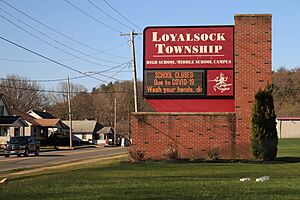
Formal education usually means schools, colleges, universities, and training centers. A 1974 report defined formal education as the structured system from elementary school through university, including academic studies and specialized training. Most data on students affected by COVID-19 was based on the closure of these formal education systems. The UNESCO Institute for Statistics provides numbers on affected students at pre-primary, primary, middle, and high school levels, as well as college and university levels. On average, elementary school teachers struggled more with the change than high school and university teachers.
Early Childhood Education
Early childhood education programs are usually for children under age 3. This includes preschools, nursery schools, kindergartens, and some day care programs. While many elementary and secondary schools closed worldwide due to COVID-19, actions affecting early childhood programs varied. In some places, like Australia, preschools and daycares were considered essential services and did not close with other schools.
In the United States, the Washington State Department of Children, Youth, and Families encouraged childcare and early learning centers to stay open. Some school districts offered alternative childcare options, prioritizing children of first responders and healthcare workers. The governor of Maryland required specific childcare services to stay open for children of emergency personnel. California Governor Gavin Newsom explained his state's position, saying, "We need our child care facilities, our daycare centers, to operate to absorb the impact of these school closures." Colorado encouraged parents to use "tool kits" at home to copy lessons children would have received in early learning programs. Over a million eligible American children did not enroll in kindergarten for the 2021–2022 school year. A 2022 report from the National Center for Education Statistics showed a 13% decrease in enrollment for eligible three and four-year-olds from 2019 to 2020.
In Japan, Prime Minister Shinzo Abe closed all schools until April 8, but children's daycare facilities were not included. In early March, five adults linked to a preschool nursing facility in Kobe tested positive for coronavirus. After testing over one hundred children, a preschool student was found to have the virus.
Elementary School
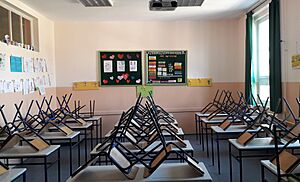
Elementary education usually covers the first four to seven years of formal schooling. Kindergarten is often the first time children experience formal education. One study predicted that COVID-19 school closures would slow the rate of reading improvement by 66% for kindergarten children. This was based on comparing how much kindergarteners learned during a spring semester versus during summer vacation. The study estimated that over an 8-month period (January 1 to September 1, 2020), assuming school closures from March 16 to September 1, these kindergarten children would have gained 31% less reading ability on average than if schools had not closed. In the United States, there was a 6% decrease in kindergarten enrollment rates for the 2019-2020 school year for five-year-olds.
Secondary School (Middle and High School)
Secondary education is where young people develop during their teenage years, a time of rapid physical, mental, and emotional growth. However, many researchers say that secondary students lost the structure they needed to do well. Instead, students struggled with working independently and risked falling behind due to distractions at home and online. The emotional well-being of secondary students was also a concern. A recent survey found that 80% of students experienced some negative impact on their mental health due to the pandemic. 20% said their mental health got significantly worse. The CDC suggests that students get plenty of rest, exercise regularly, and eat well-balanced meals to help cope with the mental stress of the pandemic.
In the United States, standardized tests for college admissions, like the SAT and ACT, adapted to offer in-person exams with fewer students and safety measures. Online proctoring was also explored to make tests more accessible. An online version of the TOEFL exam became available for students to take at home. Additionally, many colleges and universities stopped requiring standardized tests for admissions or made them optional.
The International Baccalaureate Organization (IBO) canceled exams for its Diploma Programme and Career-related Programme candidates scheduled between April 30 and May 22, 2020. This affected over 200,000 students worldwide. The IBO stated it would award diplomas or certificates based on "their coursework" and the program's existing assessment quality. College Board began offering both in-person and online testing for Advanced Placement exams in the 2020–2021 school year.
Private Schools in the United States
One effect of the COVID-19 outbreak in the United States was an increase in private school enrollment. Many parents looked for private schools because they needed a place to send their child while they worked outside the home. Despite the high cost, parents found the tuition worth it.
An unexpected result of this move to private schooling was a wider gap between families who could afford private school and those who couldn't. Families who couldn't afford it often had their children learning at home online. Problems like poor internet connection and parents not being able to properly support their children's learning (due to language barriers or work conflicts) meant some students fell behind academically.
Schools in Kenya
A study on "teachers' and parents' preparedness to support virtual learning during the COVID-19 pandemic in Kenya" showed that most parents and teachers were not ready for online learning. This problem affected all schools: public, private, and international schools in the country. This suggests that there was a weak support system for online education in Kenyan schools during the COVID-19 outbreak, which affected how well online learning was delivered.
Grade Changes
However, the IBO faced strong criticism worldwide for how they calculated students' final grades and their "Enquiry upon results" (EUR) strategy after results were released on July 6, 2020. Many students received much lower grades than their teachers predicted. They also missed the requirements to get into the universities they applied to. This affected about 170,000 students in 153 countries. As a result, online petitions with tens of thousands of signatures were created, and the hashtag "IBSCANDAL" became popular. Schools and people lost trust in the education company and are considering other options for secondary education. Educational reforms are being suggested where students might not take major exams in the future.
Higher Education (College and University)
Higher education, also known as tertiary education, refers to education after high school. This usually includes undergraduate and postgraduate education, as well as vocational training. People who complete higher education usually receive certificates, diplomas, or academic degrees.
For higher education, preparing students for future jobs is a key goal. Many jobs rely on education that involves campus activities like face-to-face interactions with other students, hands-on learning, and practical exercises. For example, doctors, nurses, and other healthcare professionals are trained through in-person observations, similar to an apprenticeship. In-person education has been shown to create stronger relationships between students and teachers, and among students, which can lead to better engagement. With COVID-19 and the switch to online learning, it was very hard to achieve the same level of deep learning. More information is needed to understand the benefits and challenges of online education and its economic impact.
Undergraduate Education (Bachelor's Degree)
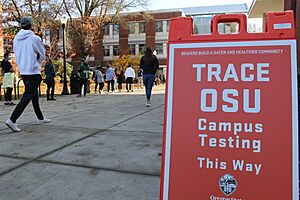
Undergraduate education is what you do after high school to get a bachelor's degree.
The closure of colleges and universities had big impacts on students, teachers, staff, and the schools themselves. In 2020, during the first period of quick changes, there were three main responses to COVID-19: very few legal changes, delays in starting study periods, and a fast switch to online learning. Decisions were made about whether learning would be optional online or in person, depending on what each university decided.
Millions of students were expected to delay starting their undergraduate degrees until a later year because of the pandemic. This not only negatively affected future university admissions due to fewer available spots, but universities worldwide were expected to lose billions of U.S. dollars because fewer students were expected to attend in the 2020–2021 academic year.
Colleges and universities across the United States were asked to give refunds to students for tuition and room and board.
While $6 billion in emergency relief money was made available to students during the pandemic, Education Secretary Betsy DeVos decided on April 21, 2020, that it would only go to students who already qualified for federal financial aid. This rule excluded tens of thousands of undocumented students who are part of the government's Deferred Action for Childhood Arrivals (DACA, or "Dreamers") program from getting emergency relief funds.
Besides colleges losing a lot of money, undergraduate students themselves lost a lot of important education because of COVID-19. With less regular education for all students, learning seemed harder to manage. Before the pandemic, college students had in-person classes, in-person office hours, and in-person extracurricular activities. However, the pandemic created a situation where students, even those who knew what job they wanted, were learning important information from behind a screen. These changes made it very difficult to focus on classes related to a student's chosen major, as they weren't fully experiencing what they were passionate about. This resulted in lost passion for certain subjects, difficulty focusing on key information, and problems with academic honesty.
Impact on Local Economies
In the United States, colleges and universities act like "mini-cities" that bring in a lot of money for cities, states, and regions. For example, Princeton University estimated in 2017 that it contributed $1.58 billion USD per year to the New Jersey economy. Students spent about $60 million on things outside of campus. College and university closures had a domino effect on economies, with far-reaching consequences.
In March, Linda Bilmes of the Harvard Kennedy School noted that "local hotels, restaurants, cafes, shops, car rental agencies and other local businesses get a lot of their yearly money from graduation week and college reunions... these communities will suffer a lot of economic damage if the colleges stay closed at that time."
Small towns that rely on college students to support local businesses and provide workers were especially affected by school closures and students leaving campus. In Ithaca, New York, Cornell University students spent at least $4 million a week in Tompkins County. After Cornell decided to keep students home after spring break and switch to online learning, the Mayor of Ithaca called for "immediate and strong federal action — we will see a terrible economic impact as a result of Cornell University closing."
See also
- COVID-19 at the University of Notre Dame
- Digital divide
- Homeschooling during the 2020 COVID-19 pandemic
- Impact of the COVID-19 pandemic on the arts and cultural heritage
- Impact of the COVID-19 pandemic on cinema
- Impact of the COVID-19 pandemic on science and technology
- Impact of the COVID-19 pandemic on sports
- Impact of the COVID-19 pandemic on religion
- Distance education in Chicago Public Schools in 1937


